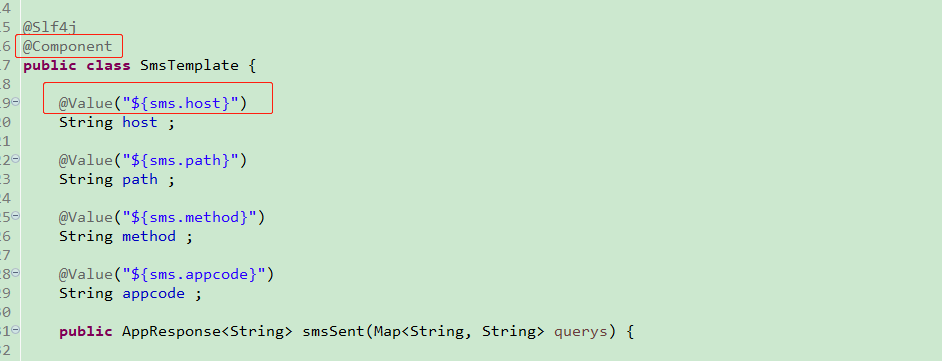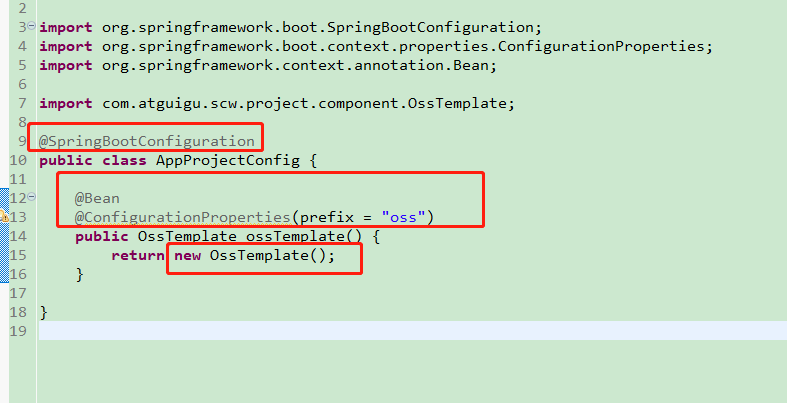第一种方法,以发送短信功能为例:
1.application.properties文件:
sms.host=http://dingxin.market.alicloudapi.com sms.path=/dx/sendSms sms.method=POST sms.appcode=xxxxxxx
2.需要注入的类,在类的上面加上@Component,在类属性上加上@Value("${sms.host}")

完整代码:
import java.util.HashMap; import java.util.Map; import org.apache.http.HttpResponse; import org.apache.http.util.EntityUtils; import org.springframework.beans.factory.annotation.Value; import org.springframework.stereotype.Component; import com.atguigu.scw.vo.resp.AppResponse; import lombok.extern.slf4j.Slf4j; @Slf4j @Component public class SmsTemplate { @Value("${sms.host}") String host ; @Value("${sms.path}") String path ; @Value("${sms.method}") String method ; @Value("${sms.appcode}") String appcode ; public AppResponse<String> smsSent(Map<String, String> querys) { Map<String, String> headers = new HashMap<String, String>(); //最后在header中的格式(中间是英文空格)为Authorization:APPCODE xxxxxxx headers.put("Authorization", "APPCODE " + appcode); Map<String, String> bodys = new HashMap<String, String>(); try { HttpResponse response = HttpUtils.doPost(host, path, method, headers, querys, bodys); log.debug("短信发送结果-----------:{}",EntityUtils.toString(response.getEntity())); //获取response的body //System.out.println(EntityUtils.toString(response.getEntity())); return AppResponse.ok(response.toString()); } catch (Exception e) { e.printStackTrace(); return AppResponse.fail(null); } } }
第二种方法,以上传文件功能为例:
1.application.properties文件:
#单个文件大小 spring.servlet.multipart.max-file-size=10MB #总文件大小 spring.servlet.multipart.max-request-size=10MB oss.endpoint=oss-cn-beijing.aliyuncs.com oss.accessKeyId=xxxxxxx oss.accessKeySecret=xxxxxxx oss.bucket=xxxxxx
2.在类上加上@SpringBootConfiguration,把类设置为springboot的配置类,在方法上面加上@Bean和@ConfigurationProperties(prefix = "oss"),赋值后注入到springboot框架,并把类的对象返回
注意:类要加上get和set方法,用lombok的@data注解也行

配置文件的代码:
package com.atguigu.scw.project.config; import org.springframework.boot.SpringBootConfiguration; import org.springframework.boot.context.properties.ConfigurationProperties; import org.springframework.context.annotation.Bean; import com.atguigu.scw.project.component.OssTemplate; @SpringBootConfiguration public class AppProjectConfig { @Bean @ConfigurationProperties(prefix = "oss") public OssTemplate ossTemplate() { return new OssTemplate(); } }
上传文件的代码:
import java.io.InputStream; import java.util.UUID; import org.springframework.stereotype.Component; import com.aliyun.oss.OSS; import com.aliyun.oss.OSSClientBuilder; import lombok.Data; import lombok.ToString; import lombok.extern.slf4j.Slf4j; @ToString @Data @Slf4j //@Component public class OssTemplate { // @Value("${oss.endpoint}") String endpoint; // 云账号AccessKey有所有API访问权限 String accessKeyId; String accessKeySecret; String bucket; public String upload(String fileName, InputStream inputStream) { log.debug("endpoint={}", endpoint); log.debug("accessKeyId={}", accessKeyId); log.debug("accessKeySecret={}", accessKeySecret); log.debug("bucket={}", bucket); String tempFileName = null; try { // 创建OSSClient实例。 OSS ossClient = new OSSClientBuilder().build(endpoint, accessKeyId, accessKeySecret); // 上传文件流。 tempFileName = UUID.randomUUID().toString().replace("-", "") + "_" + fileName; ossClient.putObject(bucket, "pic/" + tempFileName, inputStream); // 关闭OSSClient。 ossClient.shutdown(); // https://bucket.oss-cn-beijing.aliyuncs.com/pic/test.jpg String filepath = "https://" + bucket + "." + endpoint + "/pic/" + tempFileName; log.debug("文件上传后的路径:{}",filepath); return filepath; } catch (Exception e) { e.printStackTrace(); log.debug("文件上传失败-{}", tempFileName); return null; } } }